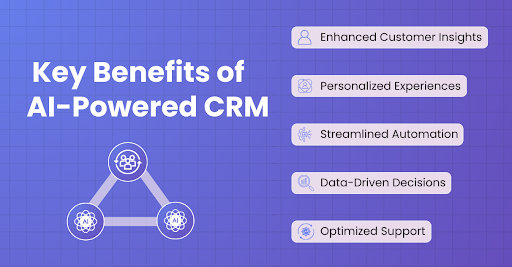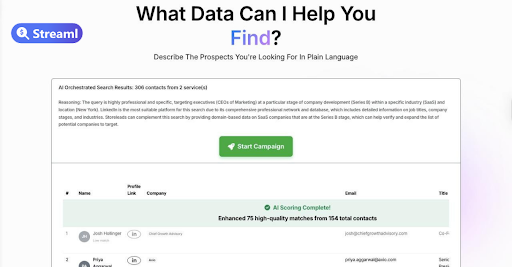In the competitive B2B SaaS landscape, AI-powered CRM platforms are revolutionizing outbound automation by leveraging predictive analytics for sales funnels, enabling real-time customer interactions, and streamlining B2B CRM strategies. These platforms act as virtual sales representatives, automating tasks, enhancing lead nurturing software, and optimizing sales lead tracking. This guide explores how AI-powered CRM boosts outbound automation, offering actionable tips to improve sales pipeline efficiency for B2B sales teams.

What is AI-Powered CRM and Its Importance?
AI-driven CRM systems centralize customer data, interactions, and relationships, enhanced by AI to deliver proactive insights. By 2025, AI in CRM is projected to drive significant growth, reflecting demand for CRM automation software.
1. Centralizing Customer Data
Tracks interactions across email, social media, and support channels for seamless communication, improving sales lead tracking. A unified data hub enables sales teams to access real-time insights, such as a prospect's recent webinar attendance or website activity, reducing manual data entry by 50% and accelerating deal progress.
2. Enhancing Retention
Personalized engagement via lead nurturing software increases retention by 15%, per industry data. By tailoring communications like targeted follow-up emails based on customer behavior, AI-driven CRM fosters loyalty. For example, sending a personalized product demo reminder can re-engage at-risk clients, minimizing churn.
3. Aligning Sales and Marketing
Unifies teams for B2B CRM strategies, boosting revenue by 20%. Shared dashboards and AI-driven insights align marketing campaigns with sales goals, ensuring consistent messaging. For instance, marketing can prioritize leads scored highly by AI, enabling sales to focus on closing high-value deals, streamlining workflows.
Why Are Companies Shifting to AI-Driven CRM?
Traditional CRMs rely on manual data entry, missing opportunities. AI-powered CRM transforms outbound automation by:
- Automating lead qualification, saving 70% of manual effort
- Personalizing outreach with AI-driven sales strategies, increasing open rates by 20%
- Scaling operations without additional staff, enhancing sales pipeline efficiency
The Role of AI in Modern CRM Systems
Unlike traditional CRMs, AI-enhanced CRM platforms use advanced technologies to act like a full-time AI employee.
1. Predictive Analytics
Analyzes browsing history and engagement for predictive analytics for sales funnels, improving conversion rates by 30%.
2. Machine Learning
Refines lead nurturing software with adaptive lead scoring, achieving 90% accuracy. By learning from past interactions, it prioritizes leads likely to convert, such as those engaging with pricing pages, reducing time spent on low-value prospects.
3. Natural Language Processing
Enables hyper-personalized emails for outbound automation, boosting engagement. NLP crafts context-aware messages, like addressing a prospect's specific pain points, increasing response rates by 25% for SaaS sales teams.
Traditional CRM vs AI-Powered CRM
| Aspect | Traditional CRM | AI-Powered CRM |
|---|---|---|
| Data Analysis | Manual review | Predictive analytics for sales funnels |
| Lead Qualification | Subjective scoring | Machine learning-based scoring |
| Outreach | Generic templates | Hyper-personalized messages |
| Pipeline Management | Spreadsheet-based | Automated sales lead tracking |
Key Benefits of AI-Driven CRM
AI-driven CRM platforms deliver transformative advantages for B2B CRM strategies.

1. Enhanced Customer Insights
Analyzes datasets for patterns, boosting conversions by 30%. For instance, identifying purchase trends across industries helps tailor pitches, enabling sales teams to close deals faster with data-backed strategies.
2. Personalized Experiences
Customizes outreach, increasing email open rates by 20% with AI-driven sales strategies. Dynamic content, such as emails tailored to a prospect's role or industry, fosters stronger connections and drives engagement.
3. Streamlined Automation
Automates lead generation and follow-ups, reducing manual work by 70%. Automated workflows, like scheduling follow-up emails based on prospect actions, free reps to focus on high-value tasks, enhancing sales pipeline efficiency.
4. Optimized Support
AI chatbots provide 24/7 assistance, escalating complex queries to agents. For example, resolving common inquiries instantly while routing technical questions to specialists improves customer satisfaction and retention.
5. Data-Driven Decisions
Churn prediction and analytics dashboards enhance sales pipeline efficiency. Real-time metrics, such as lead conversion probability, empower teams to prioritize high-potential opportunities, reducing churn by 15%.
Performance Metrics
Track KPIs to evaluate CRM automation software:
- Conversion Rates: Target 20%+ improvement with lead nurturing software
- Open Rates: Aim for 25%+ with personalized emails
- Time Savings: Reduce manual tasks by 70%
- Churn Reduction: Lower churn by 15% with predictive analytics
Cost-Benefit Analysis and Long-Term ROI
| Approach | Cost | ROI Impact |
|---|---|---|
| Traditional CRM | $20-$50/month/user | Limited by manual effort |
| AI-Driven CRM | $50-$200/month/user | 3x ROI with outbound automation |
AI-driven CRM delivers cost-effective lead generation, saving 40% on operational costs.
Real-World Applications of AI in CRM
| Tool | Key AI Feature | Primary Benefit |
|---|---|---|
| Streaml | Outbound automation | Doubles sales pipeline efficiency |
| HubSpot AI | Chatbots, personalization | Enhances CRM sales and marketing automation |
| Salesforce Einstein | Predictive lead scoring | Streamlines B2B CRM strategies |
| Zendesk | Sentiment analysis | Ties support to pipeline |
A SaaS firm using Streaml saw a 25% shorter sales cycle and doubled outbound automation efficiency.

Steps to Implement AI-Enhanced CRM
Adopt AI-enhanced CRM with a structured approach:
1. Assess Business Needs
Identify inefficiencies (e.g., manual prospecting) and set goals like automating 80% of tasks. Conduct a gap analysis to pinpoint bottlenecks, such as slow lead follow-ups, ensuring the CRM aligns with specific B2B sales objectives.
2. Select the Right Solution
Choose platforms with predictive analytics for sales funnels and scalability. Evaluate tools like Streaml for features like real-time lead scoring and API compatibility to match your team's growth needs.
3. Integrate and Cleanse Data
Use APIs for seamless integration with CRM automation software. Regularly audit data to remove duplicates and outdated contacts, ensuring accurate sales lead tracking and reliable insights.
4. Train and Deploy
Launch pilots for outbound automation, training teams for adoption. Start with a small campaign to test AI-driven features, like automated email sequences, and refine based on early results.
5. Monitor and Optimize
Track KPIs to refine sales lead tracking performance. Use analytics dashboards to monitor conversion rates and adjust strategies, such as tweaking lead scoring models, to maximize ROI.
The Future of AI in CRM Systems
By 2026, 70% of B2B firms will adopt AI-powered CRM, per Gartner.
1. Advanced NLP
Smarter chatbots enhance CRM sales and marketing automation. For example, conversational AI can handle complex customer queries, like product comparisons, improving engagement by 20%.
2. Generative AI
Dynamic content creation for outbound automation. AI-generated email templates tailored to prospect industries reduce content creation time by 50%, boosting campaign efficiency.
3. Deeper Integrations
Seamless workflows unify CRM vs. lead management. Integrating with tools like LinkedIn Sales Navigator ensures real-time data sync, streamlining lead qualification across platforms.
Conclusion
AI-driven CRM transforms outbound automation, delivering efficiency, personalization, and cost-effective lead generation. Audit your processes, test tools like Streaml, and track KPIs to stay competitive in 2025. Explore Streaml's AI-driven CRM solutions to supercharge your B2B CRM strategies.